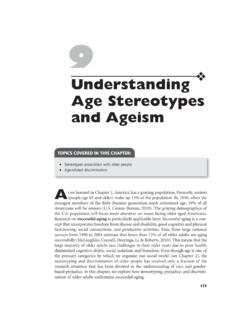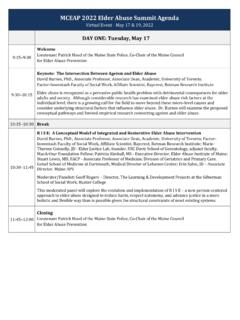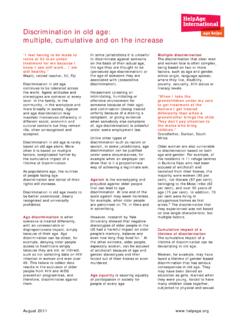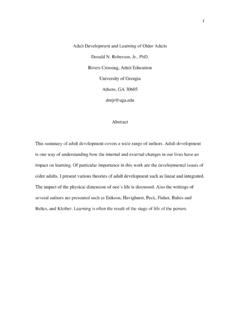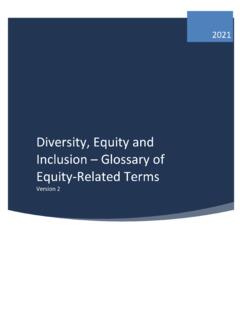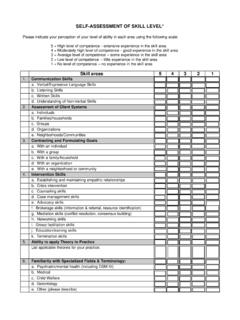Transcription of Healthy Aging in Canada - Public Health Agency of Canada
1 Healthy Aging in Canada : A New Vision, A Vital Investment A Discussion Brief Prepared for the Federal, Provincial and Territorial Committee of Officials (Seniors) 2 Participating Governments: Government of Alberta Government of British Columbia Government of Manitoba Government of New Brunswick Government of Newfoundland and Labrador Government of Northwest Territories Government of Nova Scotia Government of Nunavut Government of Ontario Government of Prince Edward Island Government of Quebec * Government of Saskatchewan Government of Yukon Government of Canada Members of the Healthy Aging and Wellness Working Group British Columbia Canada Manitoba Newfoundland & Labrador Nova Scotia Ontario Acknowledgements This brief and its complementary report were prepared for the Healthy Aging and Wellness Working Group of the Federal/Provincial/Territorial (F/P/T) Committee of Officials (Seniors).
2 The working group would like to thank Peggy Edwards and Aysha Mawani from The Alder Group who researched and drafted the larger report and prepared this brief. The opinions expressed in this document are those of the authors and do not necessarily reflect the position of a particular jurisdiction. galement disponible en fran ais sous le titre: LE VIEILLISSEMENT EN SANT AU Canada : UNE NOUVELLE VISION, UN INVESTISSEMENT VITAL * The government of Quebec contributed to the present document by sharing information and best practices, however, it is not taking part in the joint initiatives mentioned in the document because it assumes full responsibility for activities pertaining to Health and social services. 3 Healthy Aging IN Canada : A NEW VISION, A VITAL INVESTMENT About This Brief This brief was prepared for the Healthy Aging and Wellness Working Group of the Federal/Provincial/Territorial (F/P/T) Committee of Officials (Seniors) to enable discussion, debate and decisions on how to move forward to promote Healthy Aging in Canada .
3 The brief provides a strong new vision for Healthy Aging in Canada and suggests five key focus areas for action (the what). It provides the rationale and evidence for investing in Healthy Aging (the why). Lastly, it describes three essential mechanisms for action and suggests some key opportunities for moving ahead (the how). A longer complementary paper that expands on the concepts and evidence in this brief is also available. It is written for all people who develop, influence and implement policies and practices that affect the well-being of Canadians aged 65 and over. These include ministers responsible for seniors, other government decision-makers at all levels and in a variety of sectors; the nongovernmental sector (including senior s groups); service providers in Health , recreation, housing and social development; and older Canadians themselves.
4 Contents Page 1. A New Vision for Healthy Aging 4 2. A Vital Investment 6 3. Achieving the Vision 9 4. Five Key Focus Areas: The Evidence Base 12 5. Moving Forward 16 6. References 18 41. A New Vision for Healthy Aging Each of us is Aging . And as a population, Canada is Aging faster than ever before. Today, there is a more informed recognition of the important contribution that older people make to their families, communities and nation. There is also a growing understanding of the diversity of Canadian seniors in terms of age groupings, levels of independence, and ethnocultural backgrounds. Women and men experience Aging in different ways and women far outnumber men in the oldest age categories (80-plus).
5 For both men and women, there are significant differences between life at age 65, 75 and 85-plus. These groups are also heterogeneous, reflecting diverse values, educational levels and socioeconomic status. Canada is in a unique position due to immigration and Aboriginal Peoples in terms of ethnic, racial and linguistic diversity among the older population. Today, older Canadians are living longer and with fewer disabilities than the generations before them. At the same time, the majority of seniors have at least one chronic disease or condition. Our Health care system primarily focuses on cure rather than Health promotion and disease prevention. Redirecting attention to the latter is required in order to enable older people maintain optimal Health and quality of life. It will also help to manage Health system pressures.
6 The evidence is clear. Older adults can live longer, healthier lives by staying socially connected, increasing their levels of physical activity, eating in a Healthy way, taking steps to minimize their risks for falls and refraining from smoking. But there are real environmental, systemic and social barriers to adopting these Healthy behaviours. Some relate to inequities as a result of gender, culture, ability, income, geography, ageism and living situations. These barriers and inequities need to be and can be addressed now. Through a combination of political will, Public support and personal effort, Healthy Aging with dignity and vitality is within reach of all Canadians. It is time for a new vision on Healthy Aging a vision that: values and supports the contributions of older people; celebrates diversity, refutes ageism and reduces inequities; and provides age-friendly environments and opportunities for older Canadians to make Healthy choices, which will enhance their independence and quality of life.
7 5 Building on a Solid Foundation This vision for Healthy Aging builds on several key concepts and plans previously endorsed by the Ministers Responsible for Seniors: The National Framework on Aging sets out an overall vision: " Canada , a society for all ages, promotes the well-being and contributions of older people in all aspects of life" ( Health Canada , 1998). The vision for Healthy Aging seeks to further specify how this will play out by providing age-friendly environments and opportunities for older Canadians to make Healthy choices, which will enhance their independence and quality of life. Five principles identified by the National Framework on Aging underpin this vision: dignity, independence, participation, fairness and security ( Health Canada , 1998). These principles provide a common set of values for all jurisdictions that are consistent with the United Nations principles for older persons (United Nations General Assembly, 1991).
8 Planning for Canada s Aging Population: A Framework was developed by the F/P/T Committee of Officials (Seniors) to guide governments across Canada as they develop policies and programs for their Aging populations. It outlines three pillars for action: Health , wellness and security; continuous learning, work and participation in society; and supporting and caring in the community. The vision and framework for action presented in this document builds specifically on the pillar related to Health , wellness and security . 62. A Vital Investment Today, people aged 65 and older make up some 13 percent of the Canadian population. By 2031, there will be approximately nine million seniors, and they will account for 25 percent of the total If left unaddressed, the Aging of the population will have social, economic and political impacts that will far outweigh the costs of investing in Healthy Aging now.
9 In addition to the demographic imperative, there are several other important reasons to invest in Healthy Aging : 1. Seniors make a significant contribution to the richness of Canadian life and to the economy. Older people provide a wealth of experience, knowledge, continuity, support and love to younger generations. The unpaid work of seniors makes a major contribution to their families and communities. Some 69 percent of older Canadians provide one or more types of assistance to spouses, children, grandchildren, friends and Many grandparents care for their grandchildren on a part- or full-time basis; and increasing numbers of Canadian grandparents are raising their grandchildren on their As caregivers to spouses, family, friends and neighbours, seniors are a vital force in reducing Health care and social service costs.
10 Civil society programs benefit from the voluntary contributions of a large and growing number of retired seniors with valuable knowledge and skills. In addition, seniors are the largest per capita donors to Older Canadians also make an important contribution to the paid economy. More than 300,000 Canadians 65 or older were in the labour force in As demographic shifts reduce the ratio between the proportion of employed and unemployed Canadians ( , children and retired people), governments and some employers are encouraging individuals to work longer. Remaining in the workforce and actively participating in civic affairs depends, in large part, on staying in good Health . An Essential Economic Contribution In 1998, some 42 percent of Canadians aged 55-64 and 44 percent of Canadians over 65 spent an average of hours a day as volunteers.

